Transvaginal mesh implants independent review: interim report
This interim report outlines the work of the Independent Review of the use, safety and efficacy of transvaginal mesh implants in the treatment of stress urinary incontinence (SUI) and pelvic organ prolapse (POP).
Chapter 4: Assessing the safety and effectiveness of vaginal mesh surgery for stress urinary incontinence and pelvic organ prolapse in Scotland
4.1 Operations provided in Scotland for stress urinary incontinence and pelvic organ prolapse
For this study, Information Services Division (ISD) used routine hospital discharge records to identify the different operations provided for stress urinary incontinence and pelvic organ prolapse in Scotland between 1997/98 and 2013/14. Specific types of operation that were provided in reasonably high numbers were included in the analysis.
In general, only single operations were included in the analysis. 'Single' means that the woman did not have any additional/second operation for incontinence or prolapse at the same time as the operation being examined. It is quite common for women to have more than one operation at the same time. However if complications subsequently develop it can be difficult to know which operation caused the problem. Only single operations were included so that the study could focus on the risks of each particular operation separately.
In general, only first operations were included in the analysis. 'First' means that the woman had not had any other operation for incontinence or prolapse in the previous five years. Only first operations were included because the risk of complications may be quite different for a woman having a repeat operation, and it was important that the study did not mix operations with different levels of risk.
4.1.1 Operations provided for stress urinary incontinence
Open colposuspension was the main operation provided in Scotland for stress urinary incontinence in the late 1990s. Tape (mesh) procedures were introduced around 2000/01 and quickly became the most common operation type for this condition, however the number of tape procedures done fell substantially in the last year included in the analysis (2013/14). Urethral injection therapy and suprapubic sling operations have been provided in low numbers throughout the time period included in the analysis.
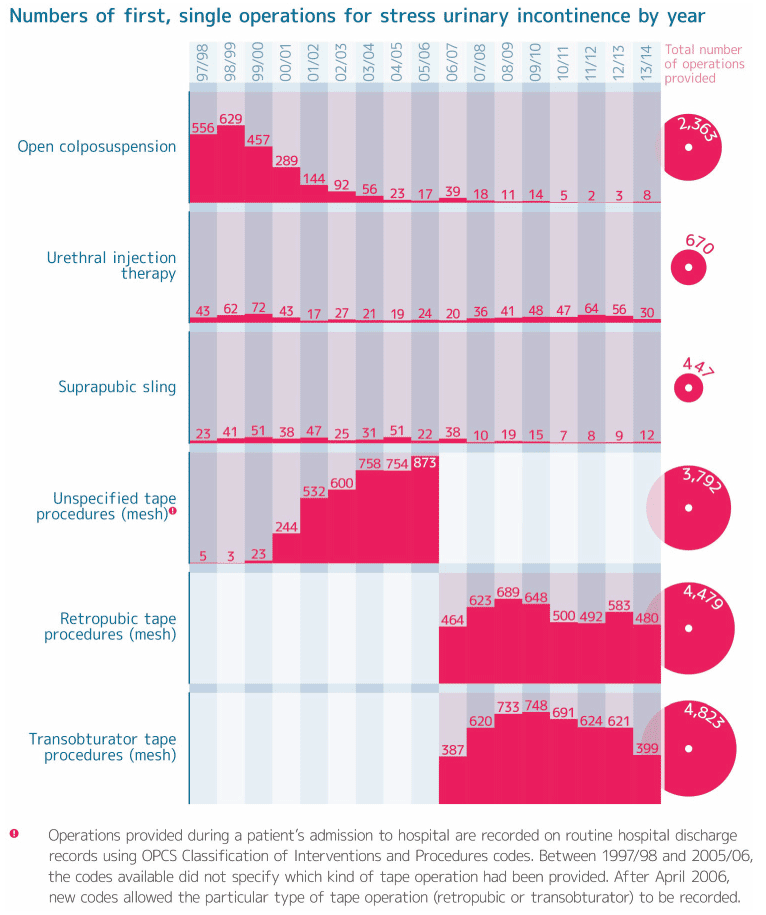
4.1.2 Operations provided for pelvic organ prolapse
Anterior and posterior colporrhaphies (first, single operations) have been provided in increasing numbers over the time period included in the analysis. Anterior and posterior mesh colporrhaphies can be identified in hospital discharge records from 2007/08 onwards. Relatively small numbers of mesh colporrhaphies have been provided in Scotland since then, and numbers provided have fallen in the most recent years.
Sacrospinous fixation operations have increased substantially over recent years. Mesh open sacrocolpopexies have been provided in moderate numbers over the time period included in the analysis. Mesh infracoccygeal colpopexies can be identified in hospital discharge records from 2006/07 onwards. Relatively small numbers have been provided since then, and numbers provided have fallen in the most recent years. Moderate numbers of (first, single) vaginal hysterectomies for pelvic organ prolapse have been provided over the time period included in the analysis.
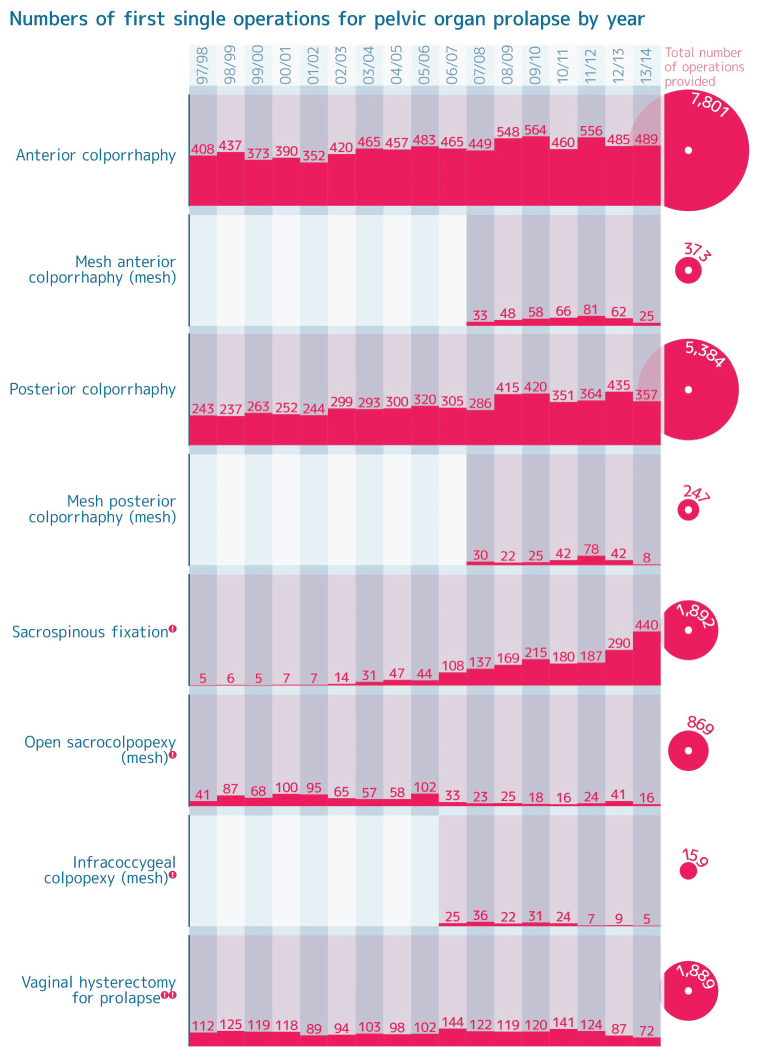

4.2 Problems after surgery for stress urinary incontinence or pelvic organ prolapse
4.2.1 Main problems
ISD looked at three main problems that can develop after an operation for stress urinary incontinence or pelvic organ prolapse. These were:
- immediate complications;
- later complications;
- further incontinence or prolapse surgery.
4.2.2 Immediate complications
'Immediate complications' means that at least one complication was recorded on the same hospital discharge record as the operation being examined; in other words the woman developed a complication when she was still in hospital following her first operation.
4.2.3 Later complications
'Later complications' means that at least one complication was recorded on a subsequent hospital discharge record; in other words the woman had been discharged home then readmitted for a complication at a later date. In general, readmissions for later complications were counted if they happened within five years of the operation being examined. Complications that would be expected to develop quickly after an operation were only counted if the readmission was within three months of the operation.
4.2.4 Further incontinence or prolapse surgery
'Further incontinence or prolapse surgery' means that at least one operation for either of these conditions was recorded on a subsequent hospital discharge record; in other words the woman had been discharged home after her first operation then readmitted for another stress urinary incontinence or pelvic organ prolapse operation at a later date. All readmissions for further surgery were counted if they happened within five years of the operation being examined.
4.2.5 What is a 'complication'?
'Complications' included the following:
- problems directly related to the operation, such as damage to the bladder or difficulty passing urine;
- excessive bleeding;
- infection;
- pain;
- partial or total removal of mesh (later complications only).
Only complications that were treated in hospital were included in the analysis. Complications treated in outpatient clinics or in general practice were not included.
4.2.6 Additional problems
ISD also looked at the following additional problems that can develop after incontinence or prolapse surgery:
- readmissions for later complications or further incontinence or prolapse surgery;
- readmissions for any reason;
- referrals to an outpatient pain clinic;
- prescriptions for strong pain relief medication that contained an opiate such as codeine;
- death.
This report shows the results relating to the three main problems only. Full results, including those relating to the additional problems, are available at Annex A.
4.2.7 The risk of developing problems after an operation
The risk of developing problems after an operation for stress urinary incontinence or pelvic organ prolapse depends on the type of operation done and on a number of other factors such as:
- age of the woman;
- how many additional health problems she has;
- how experienced the surgeon doing the operation is.
To compare the risks specifically associated with different types of operation, it is important to take account of these other factors that may be influencing the number of problems seen.
For example, if older women with a lot of additional health problems tend to have mesh colporrhaphies rather than standard (non mesh) colporrhaphies, we would expect to see more problems after mesh operations even if mesh colporrhaphy was not in itself any more risky than standard colporrhaphy.
Statistical methods can be used to take account of all the other factors that may influence the number of problems seen after different types of operation and allow us to focus on the differences that are due specifically to the type of operation that was provided.
4.3 Problems following operations for stress urinary incontinence
The risk of developing problems after the different types of stress urinary incontinence operation included in the analysis is shown below.
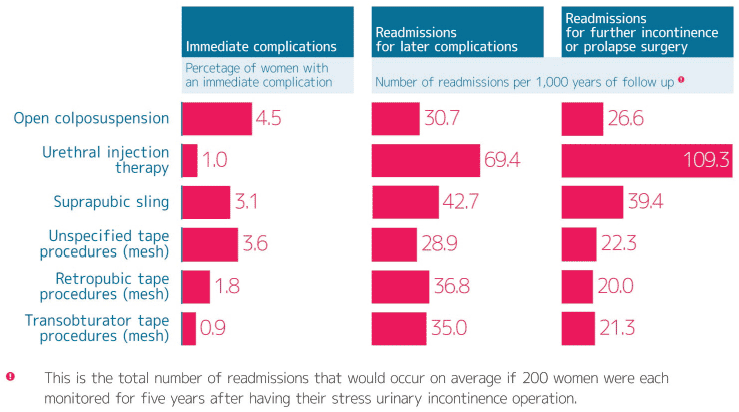
The increase or decrease in risk of the various problems following each type of operation compared to that experienced by women undergoing open colposuspension, the commonest non mesh operation, is shown below.
These final results have used statistical methods to take account of various factors that may influence the level of problems seen after operations as discussed above. The factors that have been accounted for are a woman's age, deprivation level, and additional health problems; the experience of the surgeon; and the type of hospital providing the operation.
Taking these factors into account means that the remaining differences in risk are not due to those factors and are likely to reflect genuine differences in risk associated with the different types of operation.
To help interpret these figures, a 50% decrease in risk is the same as the risk being halved, and a 100% increase in risk is the same as the risk being doubled.
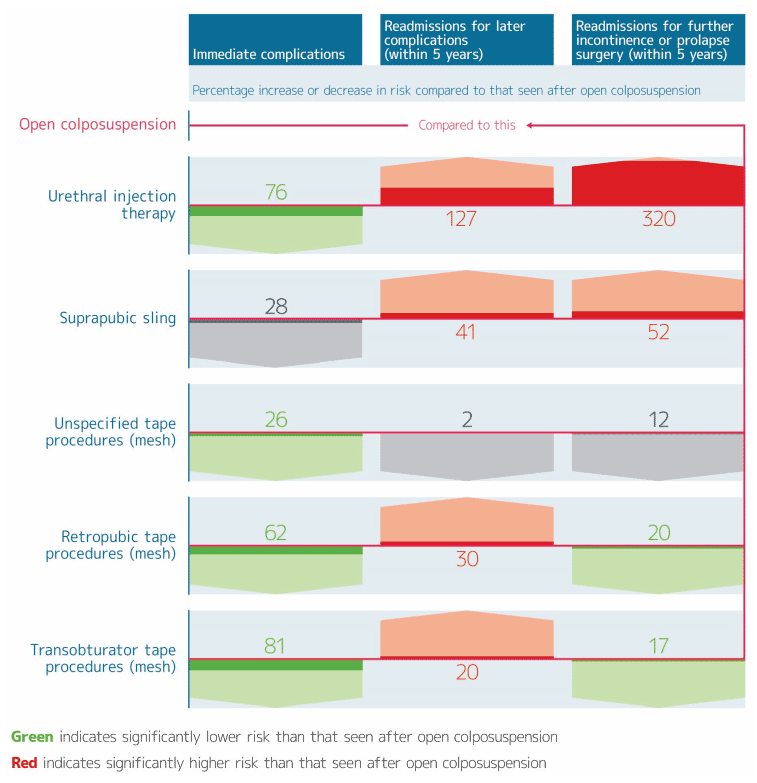
4.4 Summary of findings for stress urinary incontinence operations
Operations for stress urinary incontinence that involve operating through the abdomen (open colposuspension and suprapubic sling) carried the highest risk of immediate complications. Infections and problems directly related to the operation were the most common immediate complications following all types of stress urinary incontinence operations.
Each of the specific types of operation for stress urinary incontinence included in the analysis carried a somewhat higher risk of being readmitted for a later complication than open colposuspension. The higher risk of later complications seen for urethral injection therapy may be due to the very high risk of needing another incontinence operation after this type of surgery (see below), as every new operation carries new risk of complications. Longer term problems directly related to the operation, infections, and (for mesh operations) further surgery to remove the mesh, were the most common later complications seen after operations to treat stress urinary incontinence.
Urethral injection therapy carried a much higher risk of being readmitted for further incontinence or prolapse surgery over the five years following the initial operation than open colposuspension. Suprapubic sling operations carried a somewhat higher risk of needing another operation, and tape operations carried a somewhat lower risk. The type of further surgery needed was different for the different types of stress urinary incontinence operation. Almost all further operations following urethral injection therapy were for stress urinary incontinence, suggesting that the first operation did not completely cure the woman's incontinence. By contrast, around half of further operations following open colposuspension were for stress urinary incontinence and half were for pelvic organ prolapse, suggesting that prolapse problems developed after the colposuspension. After suprapubic slings and tape operations, around 75% of further operations were for incontinence and 25% for prolapse.
4.5 Problems following operations for pelvic organ prolapse
The risk of developing problems after the different types of pelvic organ prolapse operation included in the analysis is shown below.
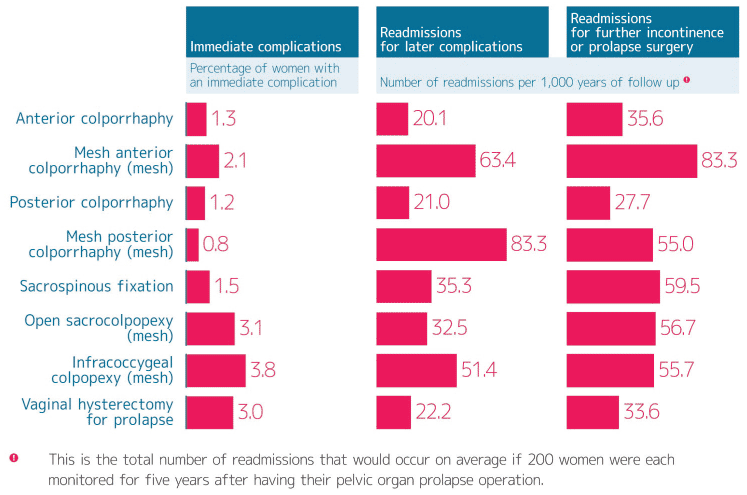
The increase or decrease in risk of the various problems following each type of operation compared to that experienced by women undergoing anterior colporrhaphy (the commonest non mesh operation) is shown on the right.
As described before, these final results have used statistical methods to take account of the various other factors that may influence the level of problems seen after these operations. The differences shown are therefore likely to reflect genuine differences in risk associated with the different types of operation.
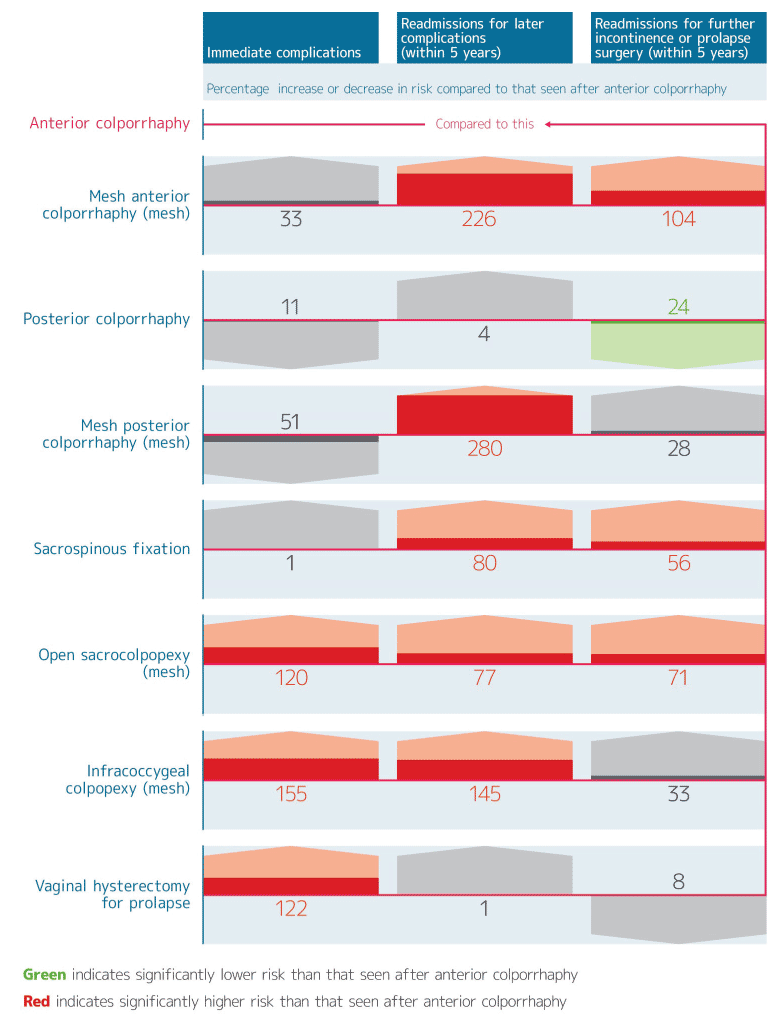
4.6 Summary of findings for pelvic organ prolapse operations
Among the pelvic organ prolapse operations included in the analysis, open sacrocolpopexy, infracoccygeal colpopexy, and vaginal hysterectomy carried the highest risk of immediate complications. In general, infections and problems directly related to the operation were the most common immediate complications following prolapse operations. Excessive bleeding was also quite common after open sacrocolpopexy and vaginal hysterectomy.
Mesh colporrhaphies (anterior and posterior), sacrospinous fixation, open sacrocolpopexy, and infracoccygeal colpopexy all carried considerably higher risk of being readmitted for a complication over the five years following the initial operation than non mesh anterior colporrhaphy. Longer term problems directly related to the operation and (for mesh operations) further surgery to remove the mesh were the most common later complications seen after operations to treat pelvic organ prolapse.
Mesh anterior colporrhaphy, sacrospinous fixation and open sacrocolpopexy carried a higher risk of being readmitted for further incontinence or prolapse surgery over the five years following the initial operation than non mesh anterior colporrhaphy. Non mesh posterior colporrhaphy carried a somewhat lower risk of being readmitted for further surgery compared to non mesh anterior colporrhaphy. Around 80% of the further operations provided after each type of pelvic organ prolapse operation were for prolapse, and around 20% were for stress urinary incontinence.
4.7 What does all this mean for women and doctors?
This study has used routinely available health information to look at:
- the number of operations provided in Scotland for stress urinary incontinence and pelvic organ prolapse;
- how often women having the different types of operation develop problems after their surgery.
Some information on the risks associated with different types of operation for stress urinary incontinence and pelvic organ prolapse was available prior to this study.
For example, there have been a number of clinical trials directly comparing different types of incontinence or prolapse operations. Clinical trials are important to improving understanding of how well operations work however they tend to only include patients who are relatively healthy and only look for problems developing quite quickly after the surgery.
In addition, in the UK, if a patient develops a problem after surgery due to a medical device such as a mesh implant, the patient's doctor is required to notify the problem to the appropriate safety regulator such as the Medicines and Healthcare products Regulatory Agency. This is an important system but it is likely that not all problems, particularly less severe problems, are notified in this way.
This study adds to these other types of information by looking at operations provided as part of routine NHS care in Scotland and looking to see how many problems develop over the five years after the operation.
When thinking about the results of this study it is important to remember that in general only first, single operations for stress urinary incontinence or pelvic organ prolapse were included and that only later complications that were severe enough to require a readmission to hospital were included.
4.8 Key Messages
No operation is without risk. It is important for women and doctors to have clear information about the different risks associated with different types of operation. This will help them decide which operation will be best for any particular woman.
The risk of immediate complications, later complications, and needing further surgery for stress urinary incontinence or pelvic organ prolapse differs between the different types of operation examined. A specific type of operation can carry a relatively high risk of one of these problems (for example immediate complications) but a relatively low risk of a different problem (for example longer term complications).
More extensive operations, for example those involving operating through the abdomen or a hysterectomy, tend to carry the highest risk of immediate complications.
Compared to open colposuspension, tape (mesh) operations for stress urinary incontinence tend to carry a somewhat higher risk of later complications but a somewhat lower risk of needing further incontinence or prolapse surgery. This highlights the difficult choices facing women and doctors as it is difficult to decide if or when the higher risk of complications would outweigh the lower risk of further surgery.
Compared to open colposuspension, urinary injection therapy carries a much higher risk of needing further surgery and an associated higher risk of later complications.
Mesh colporrhaphies for the treatment of pelvic organ prolapse carry a substantially higher risk of later complications than non mesh colporrhaphies. Mesh colporrhaphies also carry a higher risk of needing further surgery for incontinence or prolapse than non mesh colporrhaphies.
Sacrospinous fixation, open sacrocolpopexy, and infracoccygeal colpopexy for prolapse of the top of the vagina all carry a higher risk of later complications than anterior colporrhaphy. Sacrospinous fixation and open sacrocolpopexy also carry a higher risk of needing further incontinence or prolapse surgery than anterior colporrhaphy.
Contact
Email: Gillian McCallum
There is a problem
Thanks for your feedback